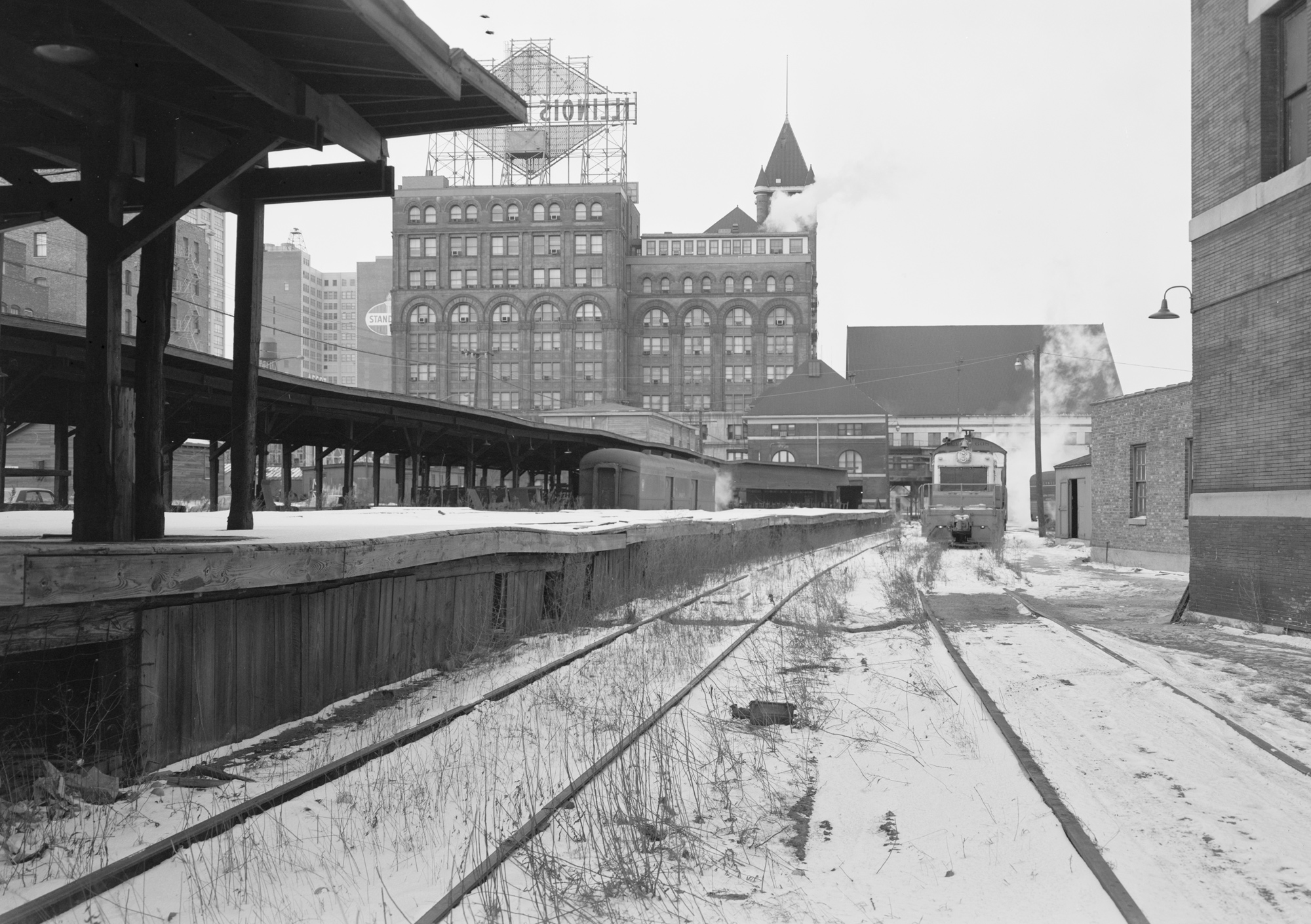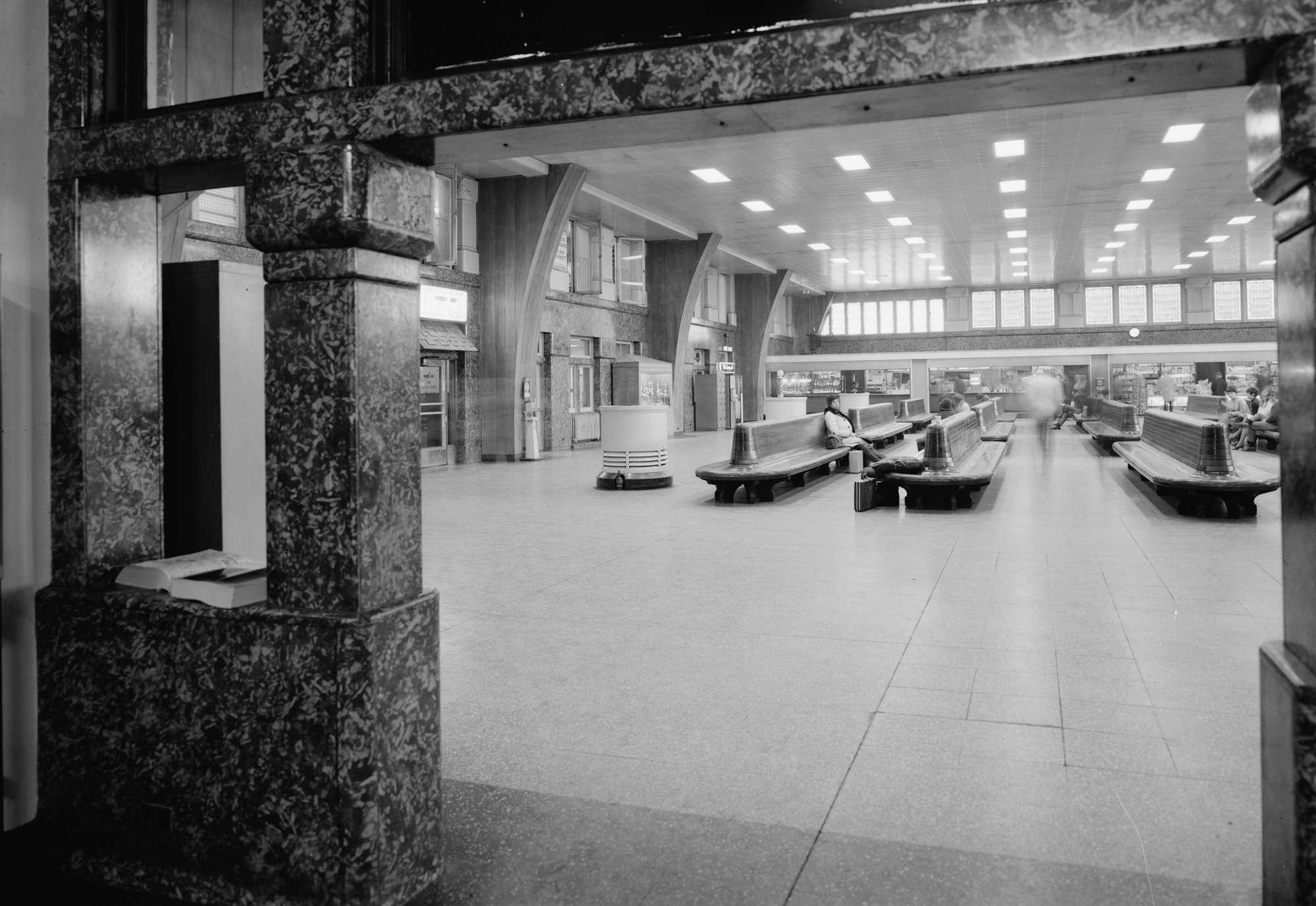Central Station: Illinois Central's Chicago Terminal
Last revised: September 9, 2024
By: Adam Burns
Central Station, also sometimes referred to as the Chicago Terminal, was the
primary hub of the Illinois Central. However, it was not the only railroad to use the facility as
others, notably the New York Central, also used the terminal.
Interestingly, Central was the busiest station in Chicago in terms of train movements despite the fact that only a handful of railroads actually used the building.
Additionally, it was not the first station used by the IC whose much smaller Illinois Central Depot, located along Randolph Street to the north, dated back to the mid-19th century.
The new terminal was, visually, incredibly stunning and of the six large railroad stations to serve Chicago, arguably the most beautiful.
Sadly, when Amtrak was created in 1971 it looked to consolidate all of the city's terminals and Central Station was one that would not survive to serve in another capacity.
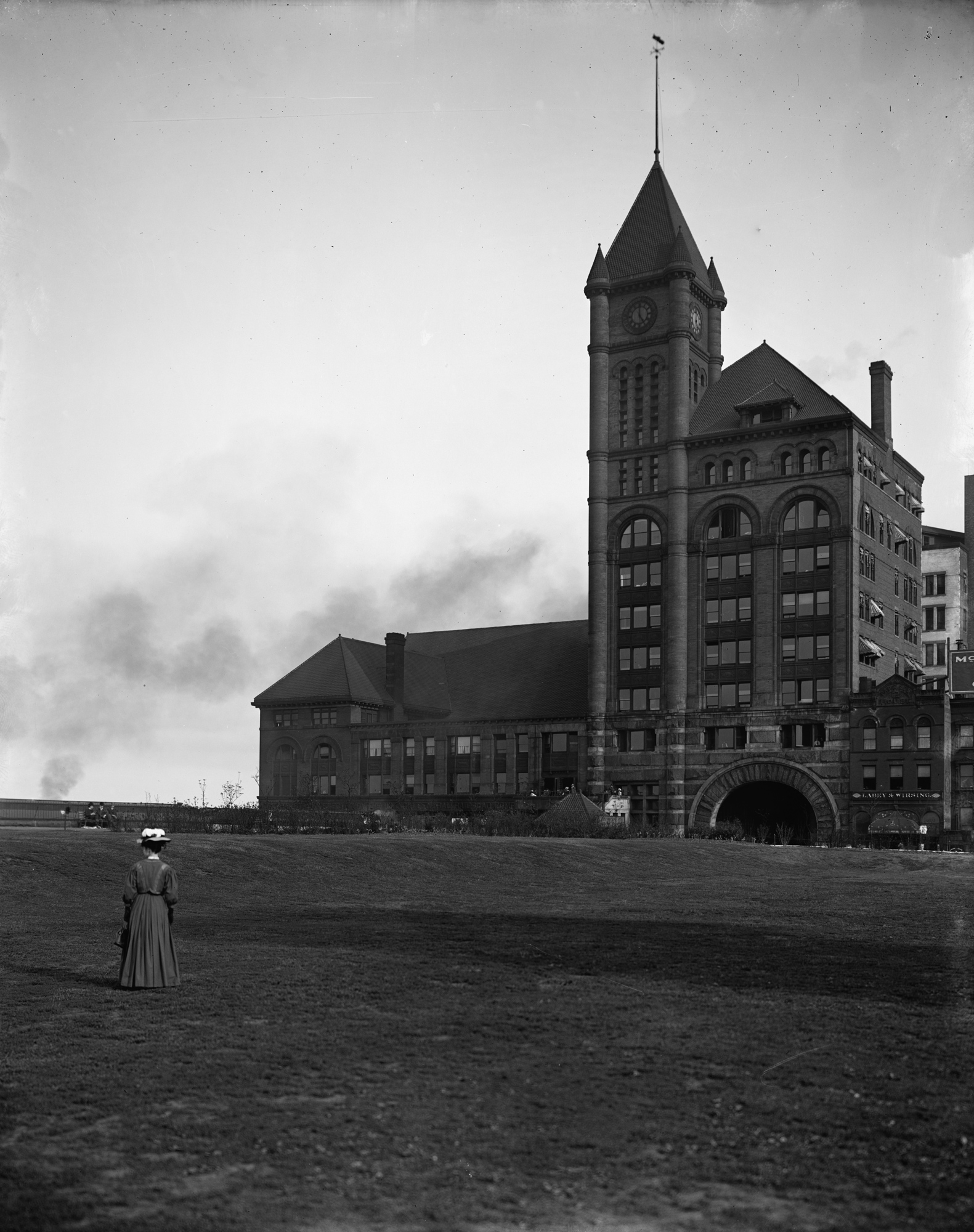 Central Station as it appeared around the turn of the 20th century. Photo by the Detroit Publishing Company.
Central Station as it appeared around the turn of the 20th century. Photo by the Detroit Publishing Company.Central Station was the Illinois Central's attempt to replace an aging station that was simply outdated and could not handle the increased capacity demanded of it.
Known as the Illinois Central Depot it was a stub-ended design that featured about a half-dozen staging tracks and was located in the heart of downtown Chicago.
The new terminal would be located just to the south, along the southwestern corner of Roosevelt Road and Michigan Avenue (and just two blocks east of Dearborn Station).
Construction of the Central Station began in the early 1890s and it would be the third-oldest of Chicago's six grand passenger terminals.
 Illinois Central's Central Station complex (clock tower) in Chicago is seen here, circa 1971. It was razed a few years later (1974), considered an eye sore.
Illinois Central's Central Station complex (clock tower) in Chicago is seen here, circa 1971. It was razed a few years later (1974), considered an eye sore.The Illinois Central hired architect Bradford Gilbert of New York to design the new station, which the railroad wanted to also include their central offices. As such, Gilbert planned a very tall structure, topping out at nine stories once it was completed.
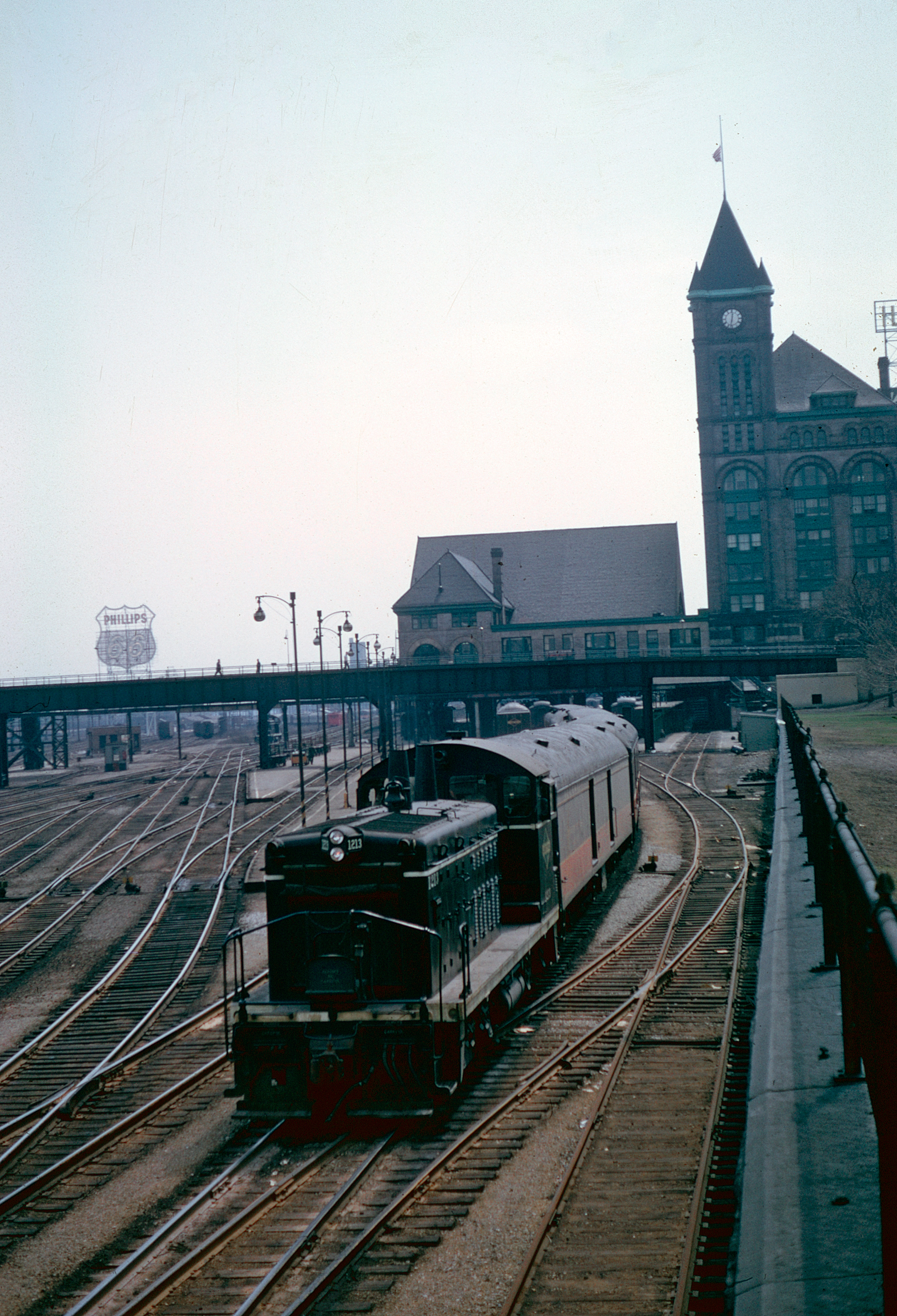 Illinois Central SW7 #1213 switches a cut of cars at Central Station in April, 1964. Author's collection.
Illinois Central SW7 #1213 switches a cut of cars at Central Station in April, 1964. Author's collection.He gave the terminal a very compact design, somewhat resembling an office building, although it was offset but a beautiful 225-foot clock tower (which actually reached 13 stories). Additionally, the architect designed the station in the Romanesque style using red brick and local sandstone.
As such, with its arched windows, rounded support columns, red-tile pitched roof, and spiral peaks the building looked very much like a Medieval Europe castle one might see in ancient France, Spain, or England.
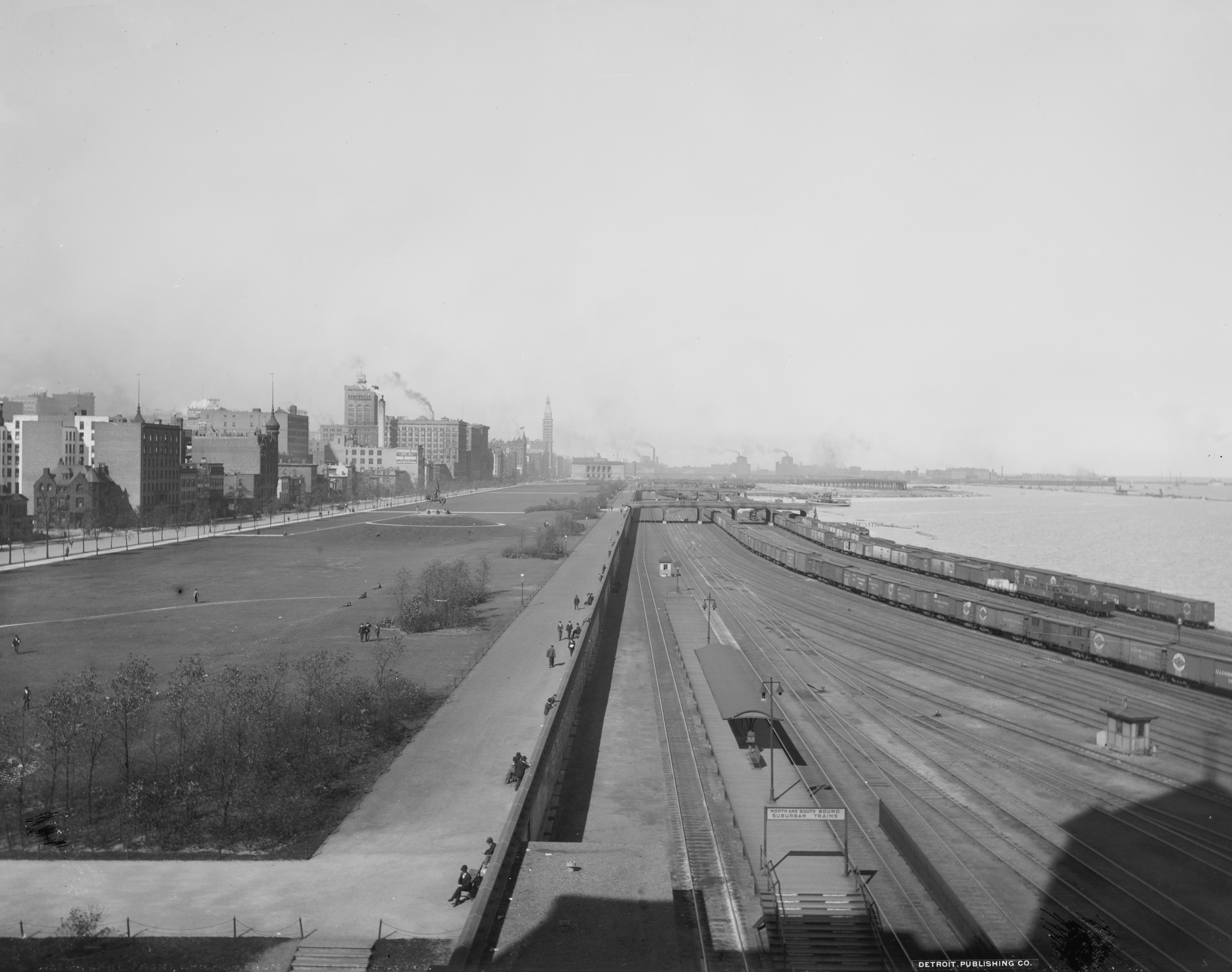 Looking north from Central Station circa 1901; Lake Michigan can be seen on the right. Photo by the Detroit Publishing Company.
Looking north from Central Station circa 1901; Lake Michigan can be seen on the right. Photo by the Detroit Publishing Company.Central Station officially opened to the public on April 17, 1893 just in time for the World's Columbian Exposition ongoing later that year.
The terminal featured a run-through design so trains did not have to back in and out of the station, which passed through the building's massive train shed (the world's largest at the time) measuring 610 feet long by 140 feet wide.
These tracks were actually located just east of the Illinois Central electrified main line through Chicago, which extended north to the Illinois Central Depot that was now exclusively used for commuters.
Passengers were treated to a magnificent three-story waiting room in the new station that constructed mostly of marble and included an outdoor balcony where one could look directly over Lake Michigan (at the time the station and tracks lay right next to the waterfront).
The large waiting room was certainly needed during the terminal's heyday of operations, which occurred from roughly the time it opened through the 1920s (and again briefly during World War II).
After the station opened, the the Cleveland, Cincinnati, Chicago & St. Louis Railway (also known as the "Big Four") used the terminal until 1922 when it officially absorbed into the New York Central.
Other railroads to use Central Station included:
- Chesapeake & Ohio (from 1925 until 1947 when it took over the Pere Marquette Railway)
- Michigan Central Railroad (another NYC subsidiary)
- Minneapolis, St. Paul & Sault Ste. Marie Railway (also known as the Soo Line, it used the building until 1912 when it moved into Grand Central Station, although it returned to the terminal after 1965)
- Pere Marquette
After the mid-1920s the Chicago, South Shore & South Bend Railroad also used the station for commuter service. Although one could not find quite the variety of paint schemes and trains at Central Station as at nearby Dearborn Station it nevertheless provided plenty to see.
For instance, all of Illinois Central's famous trains like the Panama Limited, City of New Orleans, City of Miami, Green Diamond, and numerous others used the terminal. Interestingly, as rail travel declined through the 1950s and 1960s the Illinois Central still dispatched between 10 and 20 trains per day.
Inevitably, however, the station's better days were behind it. The Illinois Central, as owner, was the last railroad to use the facility when its Panama Limited departed the terminal on April 30, 1971.
The next day, Amtrak would take over and continued to use Central Station until March 6, 1972 when it finally transferred all remaining trains to Union Station.
Despite the loss of these trains the station continued to be used as the IC's main office complex until 1974 when it completed construction of a new building, known as Two Illinois Center at 233 North Michigan Avenue.
With this the station's fate was sealed. Before 1975 the entire building was razed as some residents considered it to be an eyesore.
Today, the area is still vacant and is an extension of Grant Park although the IC's original tracks (minus the large yard) still continue northward to Metra stations at Van Buren and Randolph streets.
Recent Articles
-
Nevada's - Murder Mystery - Dinner Train Rides
Jan 07, 26 02:12 PM
Seamlessly blending the romance of train travel with the allure of a theatrical whodunit, these excursions promise suspense, delight, and an unforgettable journey through Nevada’s heart. -
West Virginia's - Murder Mystery - Dinner Train Rides
Jan 07, 26 02:08 PM
For those looking to combine the allure of a train ride with an engaging whodunit, the murder mystery dinner trains offer a uniquely thrilling experience. -
Kansas's - Murder Mystery - Dinner Train Rides
Jan 07, 26 01:53 PM
Kansas, known for its sprawling wheat fields and rich history, hides a unique gem that promises both intrigue and culinary delight—murder mystery dinner trains. -
Michigan's - Wine Tasting - Train Rides
Jan 07, 26 12:36 PM
In this article, we’ll delve into the world of Michigan’s wine tasting train experiences that cater to both wine connoisseurs and railway aficionados. -
Indiana's - Wine Tasting - Train Rides
Jan 07, 26 12:33 PM
In this article, we'll delve into the experience of wine tasting trains in Indiana, exploring their routes, services, and the rising popularity of this unique adventure. -
South Dakota's - Wine Tasting - Train Rides
Jan 07, 26 12:30 PM
For wine enthusiasts and adventurers alike, South Dakota introduces a novel way to experience its local viticulture: wine tasting aboard the Black Hills Central Railroad. -
Kentucky Thomas The Train Rides
Jan 07, 26 12:26 PM
If you’ve got a Thomas fan in the house, Day Out With Thomas at the Kentucky Railway Museum is one of those “circle it on the calendar” weekends. -
Michigan's Thomas The Train Rides
Jan 07, 26 12:10 PM
If you’ve got a Thomas fan in the house, few spring outings feel as “storybook-real” as Day Out With Thomas™ at Greenfield Village in Dearborn, Michigan. -
Texas Dinner Train Rides On The TSR!
Jan 07, 26 11:36 AM
Today, TSR markets itself as a round-trip, four-hour, 25-mile journey between Palestine and Rusk—an easy day trip (or date-night centerpiece) with just the right amount of history baked in. -
Iowa Dinner Train Rides In Boone!
Jan 07, 26 11:06 AM
If you’ve ever wished you could pair a leisurely rail journey with a proper sit-down meal—white tablecloths, big windows, and countryside rolling by—the Boone & Scenic Valley Railroad & Museum in Boon… -
Wisconsin Dinner Train Rides In North Freedom!
Jan 06, 26 10:18 PM
Featured here is a practical guide to Mid-Continent’s dining train concept—what the experience is like, the kinds of menus the museum has offered, and what to expect when you book. -
Pennsylvania Dinner Train Rides In Boyertown!
Jan 06, 26 06:48 PM
With beautifully restored vintage equipment, carefully curated menus, and theatrical storytelling woven into each trip, the Colebrookdale Railroad offers far more than a simple meal on rails. -
North Carolina ~ Murder Mystery ~ Dinner Train Ride
Jan 06, 26 11:26 AM
While there are currently no murder mystery dinner trains in the Tarheel State the Burgaw Depot does host a murder mystery dinner experience in September! -
Florida's - Murder Mystery - Dinner Train Rides
Jan 06, 26 11:23 AM
Florida, known for its vibrant culture, dazzling beaches, and thrilling theme parks, also offers a unique blend of mystery and fine dining aboard its murder mystery dinner trains. -
New Mexico's - Wine Tasting - Train Rides
Jan 06, 26 11:19 AM
For oenophiles and adventure seekers alike, wine tasting train rides in New Mexico provide a unique opportunity to explore the region's vineyards in comfort and style. -
Ohio's - Wine Tasting - Train Rides
Jan 06, 26 11:14 AM
Among the intriguing ways to experience Ohio's splendor is aboard the wine tasting trains that journey through some of Ohio's most picturesque vineyards and wineries. -
Connecticut's Thomas The Train Rides
Jan 06, 26 11:06 AM
For 2026, the tour stop at Essex brings Thomas (and Percy, too) to the historic Valley Railroad for a full day of events for the kids. -
Maryland's Thomas The Train Rides
Jan 06, 26 11:00 AM
In 2026, the B&O Railroad Museum in Baltimore welcomes the Let’s Rock, Let’s Roll Tour with four event days that combine a Thomas-themed excursion with other activities. -
Tennessee's Thomas The Train Rides
Jan 06, 26 10:51 AM
Set on the grounds of one of the Southeast’s best-known operating railroad museums, the Thomas the train event blends kid-friendly fun with the unmistakable sights, sounds, and atmosphere of a real wo… -
Georgia's Thomas The Train Rides
Jan 06, 26 10:44 AM
Day Out With Thomas is set to roll back into Cordele in 2026, bringing Thomas the Tank Engine and a full family festival to the SAM Shortline at Georgia Veterans Memorial State Park.

